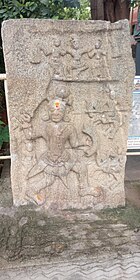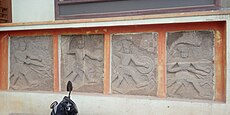Yelahanka (Bengaluru) Inscriptions and Herostones

Yelahanka is a locality in North Bengaluru, the historical administrative unit Yelahanka Naadu is mentioned variously in inscriptions as Ilaipakka, Elava, Yelavaka corresponds to the same Yelahanka. Yelahanka had been in existence prior to the 12th century. The region was called 'Ilaipakka Naadu' in Tamil during the rule of Cholas. An inscription of 1267 CE found in Doddaballapur mentions Dechi Devarasa, ruling the region with Yelahanka as his capital under the aegis of Hoysala monarch 'Narasimha III'. Later, during Hoysala reign, the city came to be known as 'Elavanka' and gradually shifted to 'Yelahanka'.[1]
TV Annaswamy in his book 'Bengaluru to Bangalore' opines that `Yelahanka' is from the word `Valipakka' meaning 'along the highway'.[2] Yelahanka's historical significance is also because of the fact that it was the seat of power to the feudal chiefs of the Karnataka Empire, the Yelahanka Mahanaadaprabhus to which Kempegowda belonged, it is said that Hiriya Kempegowda had also built a fort in the locality, However all that remains today is a toponymic reference to the fort, a road named 'Kote Beedi' translating to fort road in Kannada. The suffix naadu was a historical administrative unit, a state was divided into naadu, which were sub-divided into seeme. The present day Yelahanka houses four Kannada Inscriptions. The inscriptions were documented in Volume 9 of Epigraphia Caranatica and Quaternary Journal of Mythic Society.
Yelahanka 1410 CE Macherusha Setti Deepamaale Kamba Inscription
[edit]| Yelahanka 1410CE Macherusha Setti Venugopalaswamy Deepamale Kamba Inscription | |
|---|---|
 Digital Image of the Yelahanka 1410CE Macherusha Setti Venugopalaswamy Deepamale Kamba Inscription | |
| Material | Stone |
| Height | 96 cm (38 in) |
| Width | 96 cm (38 in) |
| Writing | Kannada |
| Created | 11-Sept-1410 |
| Discovered | 1902 |
| Discovered by | B L Rice |
| Present location | 13°06′10″N 77°35′38″E / 13.102714°N 77.593775°E |
| Language | Kannada |
| https://mythicsociety.github.io/AksharaBhandara/#/learn/Shasanagalu?id=115066 | |
It is a Kannada inscription dated to 1410CE, it records the donation of the Deepamale pillar by a Bommana Setti’s son Macherusha Setti during the reign of King Devaraya of the Karnataka Empire (Vijayanagara Empire). Deepamale is a pillar usually erected in front of some Hindu temples that have lamp like outposts in entirety, used to light lamps during festivals and other special occasions in the temple. It mentions Bommana Setti as Dashagana Bommana Setti, Dashagana is a compound word, ‘Dasha’ meaning ten and ‘Gana’, a traditional oil extraction unit, which probably means that he was an owner of ten such units. ‘Setti’ mentioned in the inscription is a common surname in southern India, refers to people who were involved in mercantile and trade activities, the surname is common even today among various caste communities like the Komatis, Nagarathars and other traditional trading communities of South India.[3]
Physical Characteristics
[edit]Transliterations of the Inscription
[edit]The transliteration was published in the Epigraphia Caranatica, the text published below is the rereading of the same inscription by the Mythic Society.[4]
Digital Images of the each of the characters of this inscription, images of the inscription itself, summary and the other information about the inscription have been shared via Aksharabhandara Software
| Line
Number |
Kannada | IAST |
|---|---|---|
| 1 | ಸ್ವಸ್ತಿಶ್ರೀ ಶಕವರ್ಷ ಸಾವಿಱದ ಮೂನೂಱ ಮೂವತಮೂಱನೆ | svastiśrī śakavarṣa sāviṟada mūnūṟa mūvatamūṟanĕ |
| 2 | ವಿಕ್ರುತ ಸಂವದರದ ಬಾದ್ರಪದ ಶುದ್ಧ ತ್ರಯೋದಶೆಯೂ ಗು | vikruta saṃvadarada bādrapada śuddha trayodaśĕyū gu |
| 3 | ರುವಾರದಲು ರಾಜಧಿರಾಜ ರಾಜಪರಮೇಶ್ವರ ಶ್ರೀ | ruvāradalu rājadhirāja rājaparameśvara śri |
| 4 | ವೀರದೇವರಾಯ ಒಡೆಯರು ಸಕಲ ಸಾಂಬ್ರಾಜ್ಯವ | vīradevarāya ŏḍĕyaru sakala sāṃbrājyava |
| 5 | ನಾಳುವ ಕಾಲದಲು ಬೊಂಮಂಣ ಅಯ್ಯಗಳ | nāluva kāladalu bŏṃmaṃṇa ayyagal ̤ a |
| 6 | ಧಂರ್ಮ್ಮ ದಶಗಾಣದ ಬೊಮಂಣ್ನಸೆಟ್ಟಿಯ ಮಗ ಮಾಚೆರೂ | dhaṃrmma daśagāṇada bŏmaṃṇnasĕṭṭiya maga mācĕrū |
| 7 | ಶ ಸೆಟ್ಟಿಯರು ಮಾಡಿಸಿದ ದೀಪಮಾಲೆಯ ಕಂಭಕ್ಕೆ ಮಂಗಳ ಮಹಾಶ್ರೀ | śa sĕṭṭiyaru māḍisida dīpamālĕya kaṃbhakkĕ maṃgala mahāśrī |
It is a Kannada inscription dated to 1440 CE and is a record of a setti (merchant) building a kamba (possibly a
| Yelahanka 1440CE Hanumanta Devara Garudakamba Inscription | |
|---|---|
 Digital Image Obtained by 3D Scanning of The Yelahanka 1440CE Hanumanta Devara Garudakamba Inscription | |
 Digital Image Obtained by 3D Scanning of The Yelahanka 1440CE Hanumanta Devara Garudakamba Inscription | |
| Material | Stone |
| Height | 38 cm (15 in) |
| Width | 114 cm (45 in) |
| Writing | Kannada |
| Created | 1440CE |
| Discovered | 2022 |
| Discovered by | The Mythic Society-Bengaluru Inscription 3D Digital Conservation Project |
| Present location | 13°06′10″N 77°35′38″E / 13.102714°N 77.593775°E |
| Language | Knnada |
Garudakamba) for a Hanumantha temple, the record also mentions that King Devaraya was ruling the empire (Karnataka Empire) at the time, much of the text cannot be read as it is effaced. The shivanasamudra mentioned in the inscription might allude to present day Hesaraghatta.[5] It is interesting to note that inscription refers to a Hanumantha temple and the temple today is known as a Sri Venugopala Swamy temple.[6]
Physical Characteristics
[edit]The first side of the inscription is 38 cm tall & 114 cm wide and the second side of the inscription is 39 cm tall & 96 cm wide. The Kannada characters are approximately 4.2 cm tall, 4.3 cm wide & 0.15 cm deep.
Transliterations of the Inscription
[edit]The inscription was first documented and the text was published in the Quaternary Journal of the Mythic Society.[6]
| Line
Number |
Kannada | IAST |
|---|---|---|
| On One Side | ||
| 1 | ಸ್ವಸ್ತಶ್ರೀ ಸಕವ . . .1303(?). ನೆಯ ರೌದ್ರಿ ಸಂವತ್ಸರದ ಪ್ರಥ. . .(ಮ?) | svastasri sakava . . 1303(?) . néya raudri samvatsarada pratha .(ma?) |
| 2 | . . . . . . ಶ್ರೀಮನ್ ಮಹಾರಾಜಾಧಿರಾಜ ರಾಜ. . . . . . | . . . . . .sriman maharajadhiraja raja. . . . . |
| 3 | . . . . . . . . . . ವರು. . . . . . . ಜದಿ(ಧಿ) | . . . . . . .varu . . . . jadi(dhi) |
| 4 | . . . .. . . . ಶ್ರೀವೀರ ಪ್ರತಾಪ ದೇವರಾಯ ಮಹಾರಾಯ. . . . . | . . . . . .srivira pratapa devaraya maharaya. . . . . . |
| 5 | . . . .. . . . . . . . . . . . . . . . . . . . . . . . . | . . . . . . . . . . . . . . . . . . . . . . . . . |
| 6 | . . . . . . . . . . . ಹಿ(?)ರಿಯಕೆ. . . . . . . .. | . . . . . . . . . . . hi(?)riyake . . . . . . . .. |
| On Second Side | ||
| 7 | . . . . .ದಿನಾಶಿವನಸಮುದ್ರದ. . . . . ರ. ಹ(?). . . . . . | . . . . . .dinasivanasamudrada. . . . . ra.ha(?). . . . . . |
| 8 | ಯ ಸೆಟ್ಟಿಯ ಮಗ . . . .ಸೆಟ್ಟಿ | ya settiya maga . . . .setti |
| 9 | . . . . . .ಶ್ರೀ ಹನುಮಂತ ದೇವರ . . . . . . | . . . . . .Srl hanumamta devara. . . . . . |
| 10 | . . . . . . . . . . .ಥ (ದ?). . . . . . . | . . . . . . . . . . .tha(da?). . . . . . . |
| 11 | ಕಂಬ ಈ ಕಂಬವನು ಮಾಡಿದ. . . . . . . . | kamba yi kambavanu madida. . . . . . . . |
| 12 | . . . . . . . . . . . .ಮಂಗಳ ಮಹಾಶ್ರೀ ಶ್ರೀ ಶ್ರೀ | . . . . . . . . . . . .mamgala mahasri Sri Sri |
It is a Tamil Inscription in Grantha Characters, as much of the text published is incomplete, the meaning of the inscription cannot be deduced. The present status of the inscription is not known. It was first documented in Volume 9 of Epigraphia Caranatica.[4]
Transliterations of the Inscription
[edit]The transliteration as published in Epigraphia Caranatica, reads as follows,
"svasti srimanu. . . . .mandalesvaran. . . . .na. . . . .malla na, vara. . .. n ana Tamma parkattikku-ppari. . . . . detta. . . . lavena kana. . .kandi maran man-tetti. . . Sohakiruti-sammasa. . . . . .ttu S'ittirai-mada nal. . . . . i-kkallu-nati … . .Velandatti udamai"
Translation
[edit]The translation as published in Epigraphia Caranatica,[7] reads as follows,
"While the (maha) mandalesvara, (Tribhu)vanamalla (on the date specified) set up this stone."
| Yelahanka 1800CE Kanteerava Arasa's Garuda Kambha Inscription | |
|---|---|
 Digital Image of the Yelahanka 1800CE Kanteerava Arasa's Garuda Kambha Inscription | |
| Material | Stone |
| Height | 33 cm (13 in) |
| Width | 40 cm (16 in) |
| Created | 1800CE |
| Discovered | 1902 |
| Discovered by | B L Rice |
| Present location | 13°06′10″N 77°35′38″E / 13.102714°N 77.593775°E |
| Language | Kannada |
| https://mythicsociety.github.io/AksharaBhandara/#/learn/Shasanagalu?id=115136 | |
It is a Kannada inscription dated to the 1800CE which records the donation of the Garuda Kambha by Kanteerava Arasa, the son of Kikkeri Kemparajaiya. Garuda Khambas were pillars erected in front of Vishnu Temples which usually had Vaishnavite Sculptures, according to Puranic Mythology, Garuda (brahminy kite) is considered to be the vehicle of Lord Vishnu. Kikkeri as mentioned in the inscription is presently located in KR Pete Taluk of Mandya District. The inscription is documented in Epigraphia Carnatica Volume 9 as Bengaluru Inscription Number 17.[3]
Physical Characteristics
[edit]The inscription is 38 cm tall & 113 cm wide. The Kannada characters are approximately 4.2 cm tall, 4.3 cm wide & 0.15 cm deep.
Transliterations of the Inscription
[edit]The transliteration was published in the Quaternary Journal of Mythic Society.[6]
Digital Images of the each of the characters of this inscription, images of the inscription itself, summary and the other information about the inscription have been shared via Aksharabhandara Software
| Line
Number |
Kannada | IAST |
|---|---|---|
| 1 | ಪರಾಭವ ಸಂವ | parābhava saṃva |
| 2 | ತ್ಸರದ ಆಸ್ವಿಜ ಶು ೧೦ | tsarada āsvija śu 10 |
| 3 | ಕಿಕೇರಿ ಕೆಂಪರಾಜೈನ | kikeri kĕṃparājaina |
| 4 | ವರ ಮಗ ಕಂಠೀರ | vara maga kaṃṭhīra |
| 5 | ವರಸನವರ ಸಾವೆ | varasanavara sāvĕ |
Gallery
[edit]-
Yelahanka Venugopala swamy temple Garudakamba
-
3D Scanning of The Yelahanka 1440CE Hanumanta Devara Garudakamba Inscription
-
3D Scanning of The Yelahanka 1440CE Hanumanta Devara Garudakamba Inscription
-
A Veeramasti Memorial Stone Dating to 9-10th Century
-
Yelahanka 1410CE Macherusha Setti Venugopalaswamy Deepamale Kamba Inscription
-
Herostones at Yelahanka Dating to 9-10th Century
References
[edit]- ^ Shaasana Parishodhane by Dr M.G. Manjunaatha, Dept. of Kannada, Mysuru Univ.
- ^ Shekhar, Divya (July 14, 2016). "The origins of Bengaluru city is closely linked to Yelahanka". The Economic Times.
- ^ a b "StoneInscriptionsOfBangalore by Udaya Kumar P.L - Issuu". issuu.com. August 20, 2017.
- ^ a b "Epigraphia carnatica. By B. Lewis Rice, Director of Archaeological Researches in Mysore". Bangalore Mysore Govt. Central Press. 1894.
- ^ "Kannada Inscriptions of Bangalore - Tracing History One Stone At A Time". Karnataka.com. May 28, 2018.
- ^ a b c "Quarterly Journal of the Mythic Society (QJMS) VOl 113 2 2022 43 Undocumented Bengaluru Inscriptions". April 2022.
- ^ "Epigraphia carnatica. By B. Lewis Rice, Director of Archaeological Researches in Mysore". Bangalore Mysore Govt. Central Press. 1894.





